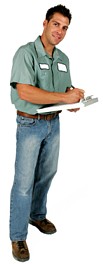Introduction to Ants
Ants, the most common household pest, can be a mere nuisance or more than that: there are some that just want to share the food, but others sting or damage building materials. Here is some information about dealing with these insects.
Recognizing Ants
In the same family with bees and wasps, the ant is a member of a group of insects with thousands of species, some of which are household pests. They can range in size from 0.1” (.25 cm) to 1” (2.54 cm), and are variously yellow, red, brown, black, or a blend. Being omnivorous, they eat human food as well as waste. In addition, the carpenter ant creates living area in wood, often choosing sites where the wood is wet and damaged. Ants have a clearly delineated 3-section body (head, thorax, and abdomen), six legs, compound eyes, and a pair of antennae. Some have stings, and some can spray poison. Some varieties have wings. They are nocturnal, being most active at night.
Ridding Your Home of Ants
Once you identify ants in your home, you need to decide what form of treatment to use. In any case, it is important to eliminate food sources if possible, as well as use some substance that will kill them. Eliminating food sources may include:

- Carefully wiping the outside of all containers that are used to store attractive food stuffs, such as honey and molasses.
- Cleaning all dinnerware, pots and pans, kitchen utensils and flatware after each meal is prepared and served.
- Washing all dining and food preparation surfaces, whether tables, trays, desks, and including those on porches and patios adjacent to the house. Since ants avoid vinegar and citrus, cleaners with either of these will tend to keep them away.
- Eliminating any crumbs from surfaces below the eating area after each meal.
- Securing waste in plastic and removing it from the premises every evening.
- Sweeping/washing the kitchen floor every evening.
- Removing uneaten pet food and cleaning the surrounding area after every meal the pet has.
- Keeping extra pet food in a sealed, hard plastic container.
- Storing pantry items (including, but not limited to, flour, cereal, crackers, cookies, etc.) in sealed, hard plastic containers.
- Finding and repairing any leaks that could be providing a source of water.
If you find ants already in any food item, discard it.
Because ants are so small, it is probably impossible to seal all possible access. So, the next steps are to find the access being used in this instance and seal it, and eliminate the nest.
Since ants like to parade in line, it may be fairly easy to find the point of entry that they are using. When found, seal it with appropriate material, for example, caulk. Petroleum jelly can be used as a temporary sealant. The ants inside can be quickly eliminated with a household cleaning spray.
The ants you find indoors may have nests either in or out of the house. Carpenter ants tend to nest inside; while other species often have their nests in the soil outside and enter the house seeking food or water. For ants nesting in the woodwork, it may be necessary to find the nest in order to have the integrity of the structure confirmed, and for this, professional assistance may be necessary. For outside nests, if sealing the ants’ point of entry doesn’t work, the best approach is often to use poison bait, and let the ants carry the poison to the nest, which will, in effect, destroy it. If there are children or pets in the household, make sure you consider them in choosing your course of action.
Written by Mary Elizabeth
Related Home Institute Articles
